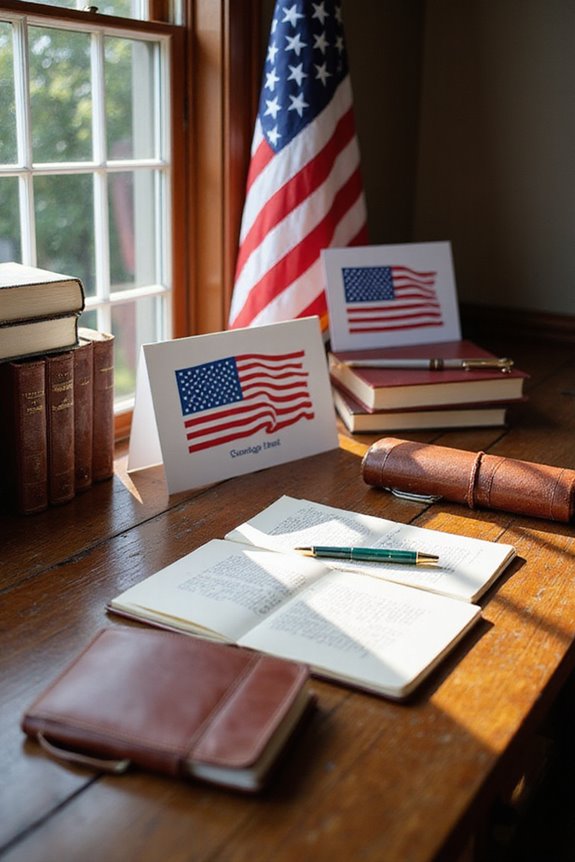Designing political calendars requires careful consideration of several key aspects:
- We must establish uniform dates for voter registration and early voting.
- Coordinating local and national election timelines boosts voter turnout considerably.
- It’s essential to comply with legal mandates, like the Help America Vote Act.
- Engaging stakeholders enhances voter education and outreach.
By prioritizing administrative tasks and maintaining clear communication, we can create effective calendars. Further insights on optimizing these strategies await ahead.
Key Takeaways
- Establish uniform dates for voter registration, early voting, and absentee voting to streamline electoral processes.
- Organize events chronologically to enhance transparency and accessibility for voters.
- Prioritize events by listing eligible bills and legislative items to direct focus on key electoral activities.
- Ensure compliance with legal mandates like the Help America Vote Act when creating political calendars.
- Collaborate with stakeholders to improve voter education and outreach, integrating their input into the calendar design.
Understanding the Components of Political Calendars
Political calendars are crucial tools that help us navigate the complex landscape of elections and legislative processes. They serve several critical functions, including:
- Key Dates and Uniform Deadlines: Calendars establish uniform dates for voter registration, early voting, and absentee voting, ensuring compliance with election laws.
- Legislative Process Scheduling: They list bills and legislative items eligible for consideration, aiding in event prioritization based on political leadership decisions.
- Task Sequencing and Dependencies: Calendars outline sequences of administrative tasks, like ballot printing and poll worker training, which are essential for election administration. Additionally, they incorporate scheduled election events that provide a comprehensive view of important electoral dates.
- Event Types and Scope: They incorporate various events, from primaries to special elections, allowing for calendar synchronization across jurisdictions.
- Data Representation and Reporting: Reports organize events chronologically, ensuring transparency and accessible information for stakeholders.
The Role of Election Authorities in Calendar Design

Election authorities play a pivotal role in designing the political calendar, guaranteeing that the electoral process runs smoothly and meets legal requirements. Here are some key aspects of their responsibilities:
- Election Calendar Responsibilities: They create calendars that align with legal mandates, covering all election dates and deadlines.
- Voter Instruction Timelines: Timely dissemination of voter instructions, including mail-in ballot processes, is essential for voter participation. This is particularly important since voter education should align with election milestones. Effective voter education can also be supported by top political news sources that provide accurate information about the electoral process.
- Administrative Tasks: Calendars outline important tasks like securing polling places and managing ballot design.
- Compliance: Adhering to laws, such as the Help America Vote Act (HAVA), influences the calendar’s content and task timing.
- Coordination: They collaborate with stakeholders to guarantee effective voter education and outreach, enhancing electoral participation.
Through these efforts, election authorities support a transparent and organized electoral process.
Impact of Timing on Voter Turnout

Understanding how timing affects voter turnout is essential for fostering a participatory democracy. Election synchronization plays a crucial role in maximizing voter engagement and turnout levels.
- Local elections held concurrently with state or national elections witness markedly higher turnout, often exceeding 30 percentage points. Federal election dates can vary from November 2 to November 8, which can influence local election scheduling. Additionally, effective political sign messaging can help raise awareness and encourage participation during these elections.
- When city elections align with presidential elections, turnout rates can double compared to off-cycle elections.
- On-cycle elections not only improve turnout but also enhance the representativeness of the voter pool, reducing the influence of special interest groups.
- Empirical studies confirm that timing impacts turnout more than many reforms, establishing a strong case for strategic election scheduling.
Strategic Considerations for Election Organizers

As we consider the multifaceted nature of organizing elections, it is vital to focus on strategic planning that enhances both efficiency and effectiveness.
- Pre-Planning Sessions: Structured sessions help define our strategic objectives and set clear priorities. Effective strategic planning becomes crucial amid the complexities of election organization. Additionally, incorporating thorough research can provide valuable insights that inform our strategic direction.
- Committee Roles: A dedicated planning committee can draft materials and assess organizational needs.
- Stakeholder Engagement: Regular meetings with election officials and partners guarantee that everyone’s goals align.
- Feedback Mechanisms: Gathering input from advisory boards and the public refines our strategies.
- Communication: Consistent messaging reinforces our mission and fosters alignment across the organization.
Influencing Factors on Political Agendas

Political agendas are shaped by a complex interplay of various factors, each influencing the prioritization of issues in notable ways.
- Media Influence: The media notably affects political agendas by determining which topics gain exposure. Sensational content often overshadows in-depth policy discussions, shaping public concern and, in turn, pressuring policymakers. Agenda-setting theory posits that increased media coverage correlates with heightened public perception of issue significance. Additionally, the importance of historical context can provide insights into how current political narratives are framed.
- Political Opportunity: Certain issues emerge based on recognized problems and political opportunities. Leadership endorsements can sustain attention on critical topics, though competing priorities may hinder policy proposals. Historical developments often influence which issues gain traction in the political arena.
- Agenda Dynamics: The alignment of problem, politics, and policy streams is essential for issues to gain sustained agenda status.
- Societal Factors: Cultural values and social harms often motivate agenda items, reflecting broader societal concerns that influence political priorities. The evolution of political thought can also shape public perception and priorities over time.
Best Practices for Effective Calendar Communication
Effective calendar communication is essential for the success of any political campaign, as it guarantees that our messages resonate with voters and align with campaign objectives. To guarantee calendar alignment and message synchronization, we should:
- Set clear communication goals that mirror campaign objectives.
- Define primary messages early, reinforcing core themes across all platforms.
- Develop a timeline that maps proactive messaging to key events.
- Tailor messages for distinct voter groups, using research to address their specific concerns.
- Utilize a centralized communications calendar for transparency and organization.
- Maintain consistent messaging to build a recognizable brand.
- Regularly review and adjust our communications based on feedback and evolving circumstances. Utilizing a communications calendar enhances overall campaign execution. Additionally, structured study plans can reinforce the importance of timely and organized communication in political contexts.
Frequently Asked Questions
How Are Political Calendars Updated During Election Cycles?
We update political calendars throughout election cycles by adjusting election timelines and reflecting changes in campaign strategies. This guarantees accurate tracking of critical events and deadlines, keeping voters informed and engaged as circumstances evolve.
What Technology Is Used for Managing Political Calendars?
As we navigate the bustling landscape of political campaigns, we rely on digital tools and scheduling software to streamline our efforts, ensuring every essential date and task is seamlessly organized and easily accessible for our team.
Who Decides on Changes to Established Political Calendars?
When it comes to changes in established political calendars, we see that calendar authorities, often influenced by political parties, have the power to propose and enact adjustments based on strategic needs and compliance with legal frameworks.
How Do Political Calendars Vary Between States?
Political calendars vary widely between states due to differing state regulations and election timelines. We see variations in election dates, polling places, and administrative processes, which can really impact voter experience and turnout.
Can Political Calendars Influence Voter Registration Trends?
We’d say political calendars have a subtle way of shaping voter engagement. Timing can spark registration drives, encouraging participation. When we align events thoughtfully, we foster a thriving atmosphere for increased voter registration and turnout.






